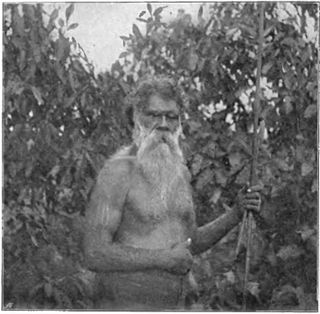The Diyari, alternatively transcribed as Dieri, is an Indigenous Australian group of the South Australian desert originating in and around the delta of Cooper Creek to the east of Lake Eyre.
The Bigambul people are an Aboriginal Australian people of the Northern Tablelands and Border Rivers regions of New South Wales and Queensland.

The Krauatungalung are an Indigenous Australian people, of East Gippsland, in the state of Victoria, Australia. They are regarded as a group of the Kurnai, though Tindale states that their inclusion as one of the Gunai is artificial.
The Brabiralung are an Indigenous Australian people, one of the five clans of Gippsland, in the state of Victoria, Australia, belonging to a wider regional grouping known as the Kurnai.
The Gunggari, or Kunggari, are an Aboriginal Australian people of southern Queensland. They are to be distinguished from the Kuungkari.
The Kuungkari are an indigenous Australian people of Queensland. They are to be distinguished from the Kunggari.
The Taribelang are an Aboriginal Australian people of central Queensland.
The Antakirinja, otherwise spelt Antakarinya, and alternatively spoken of as the Ngonde, are an indigenous Australian people of South Australia.
The Kuyani people, also written Guyani and other variants, and also known as the Nganitjidi, are an Aboriginal Australian people of the state of South Australia who speak the Kuyani language. Their traditional lands are to the west of the Flinders Ranges.
The Wangkangurru, also written Wongkanguru and Wangkanguru, are an Aboriginal Australian people of the Simpson Desert area in the state of South Australia. They also refer to themselves as Nharla.
The Ngameni are an indigenous Australian people of South Australia who once spoke the Ngameni language.
The Yawarrawarrka were an in Indigenous people of South Australia.
The Bidjara people, also spelt Bitjara or Bithara, are an Aboriginal Australian people of south-western Queensland. They spoke a dialect of the Ngura language. They are not to be confused with the Warrego River Pitjara or the Badjiri of the Paroo River, both of whose traditional lands are further to the east of the state.
The Punthamara were an indigenous Australian people of the state of Queensland.
The Maikulan were an indigenous Australian people of the state of Queensland. They have sometimes been confused with the Maithakari.
The Kunandaburi or Karendala (Garandala) were an indigenous Australian people of the state of Queensland.
The Yagalingu were an indigenous Australian people of the state of Queensland. Their language may have been a dialect of Bidjara.
The Marulta were an indigenous Australian people of the state of Queensland, Australia.
The Dhirari were an indigenous Australian people of the state of South Australia. They are not to be confused with the Diyari people, though the Dirari/Dhirari language was a dialect of the Diyari language.
The Karangura were an indigenous Australian people of South Australia.